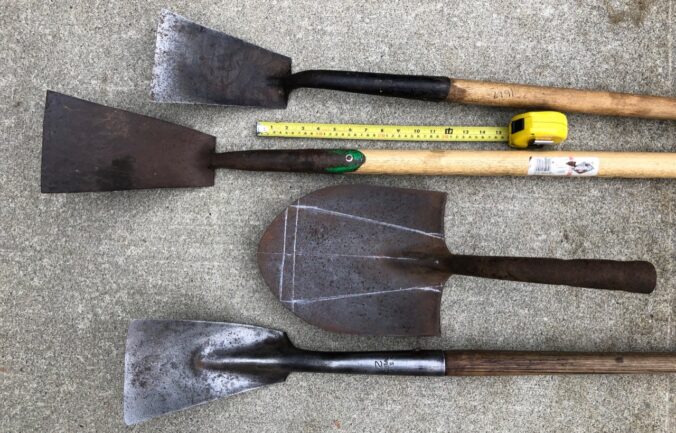The fishtail spade has become my go to, first choice tool for all-day gardening and grounds maintenance work. While common and valued among wood workers, the triangular fishtail shape is mostly unknown among earth workers.
Three simple cuts transform a standard pointed shovel into an elegant, strong, multipurpose tool. Use this tool to hoe, edge, transplant, dig, harvest, chop, scrape, skim, lift turf, toss stones, clear brambles and much more. With excellent balance, 3 working edges, 2 working surface and weighing only 2.5 lbs, the spade is used with one or both hands
Instructions
To try yourself, follow the chalk cut lines as illustrated in the photo. Dimension guidelines are: front edge 5 to 6 inches wide, side edges 9 to 10 inches long, throat 3 inches wide. An angle grinder with a thin kerf cutting blade easily cuts the shape. Back beveling the front and side edges with a grinding disc completes the metal work. Attach a straight handle for an overall length of about 52 inches or mid-chest height.
Note that some shovel head profiles are more suitable for fishtail spade transformations. Featured in the photo is my favorite “Blossom” made from a stamped shovel head which profile has 2 sweep curves: one parallel and one perpendicular to the long axis. Together the sweeps form a gentle scoop pocket not unlike a slightly cupped hand.
Versatile absolutely. Field tested. So an analysis of why the fishtail is different. Wood workers have a long history of using the shape for chisels and gouges
Analysis:
- weight – 1/3 reduction over the standard long handled pointed shovel from 5 1/4 lb to 3.5 lb. dropping 1 3/4 lbs of unneeded steel.
- edges – 3 edges total 25 inches overall. A 6 inch dutch hoe has 2 edges for 12 inches overall.
- balance – handle length of 52″ has excellent balance familiar to canoe paddlers
- tasks field tested – hoe, edge, transplant, pry, scoop, stone toss, turf lift, dig, harvest, loping branches, taming brambles, adjust grades
Conclusion
Without question, my most useful outdoor hand garden tool. An example of an economy of scope: same or less inputs with higher service level output. One tool that replaces many others, is easy to build with low capital input and easy to use. Does 80% of jobs, 100% well.

Recent Comments